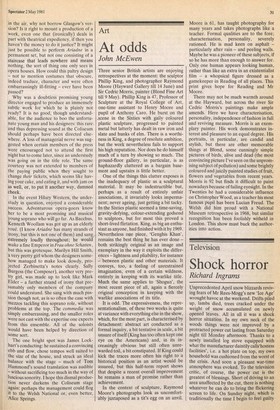Art
At odds
John McEwen
Three senior British artists are enjoying retrospectives at the moment: the sculptor Phillip King, and photographer Raymond Moore (Hayward Gallery till 14 June) and Sir Cedric Morris, painter (Blond Fine Art till 9 May). Phillip King is 47, Professor of Sculpture at the Royal College of Art, one-time assistant to Henry Moore and pupil of Anthony Caro. He burst on the .scene in the Sixties with gaily coloured plastic sculpture, progressed to painted metal but latterly has dealt in raw iron and slate and hunks of elm. There is a worthiness in King, a degree of resolute ambition, but the work nevertheless fails to support his high reputation. Nor does he do himself much of a turn by showing so much. The ground-floor gallery, in particular, is as haphazardly cluttered as a bargain basement and upstairs is little better.
One of the things this clutter exposes is the inadequacy of plastic as a sculptural material. It may be indestructible but, perhaps as a result of entirely unfair associations, it invariably looks impermanent; never ageing, just getting a bit tacky. In the Sixties plastic seemed a time-saving, gravity-defying, colour-extending godsend to sculptors, but for most this proved a short-lived flirtation. King, as big an enthusiast as anyone, had finished with it by 1969. Nevertheless oue piece, 'Genghis Khan', remains the best thing he has ever done both strikingly original as an image and exemplary in the way it exploits the differences — lightness and pliability, for instance — between plastic and other materials. It conveys, too, a feeling of unrestrained imagination, even of a certain wildness, entirely in keeping with its warlike title. Much the same applies to 'Shogun', the most recent piece of all, again a fiercely original conception in keeping with the warlike associations of its title.
It is odd. The expressiveness, the representationalism, of these two works is quite at variance with everything else in the show, which, for the most part, is characterised by detachment: abstract art conducted as a formal inquiry, a bit tentative in scale, a bit unsure of itself (King has too often kept one eye on the Americans) and, in its increasingly obvious but still often unrewarded toil, a bit constipated. If King could kick the traces more often his right to a historical position as an artist would be assured, but this half-term report shows that despite a recent overall improvement he remains a man of promise rather than achievement.
In the context of sculpture, Raymond Moore's photographs look as uncomfortably juxtaposed as a tit's egg on an anvil. Moore is 61, has taught photography for many years and takes photographs like a teacher. Formal qualities are to the fore; characterisation, personality, severely rationed. He is mad keen on asphalt — particularly after rain — and peeling walls. Maybe he was a pioneer of these subjects, if so he has more than enough to answer for. Only one human appears looking human, rather than like an extra in an existentialist film — a whopsical figure dressed as a gamekeeper in Reading of all places. This print gives hope for Reading and Mr Moore.
There may not be much warmth around at the Hayward, but across the river Sir Cedric Morris's paintings make ample amends. Here we have characterisation, personality, independence of fashion in full and reviving measure. Morris is an exemplary painter. His work demonstrates interest and pleasure to an equal degree. His portraits, in particular, are candid and stylish, but there are other memorable things at Blond, some cunningly simple pictures of birds, alive and dead (the most convincing picture I've seen on the unpromising subject of pollution) and some brightly coloured and juicily painted studies of fruit, flowers and vegetables from recent years. Morris is 92 but finds it difficult to paint nowadays because of failing eyesight. In the Twenties he had a considerable influence on Christopher Wood, as a teacher his most famous pupil has been Lucian Freud. The Welsh did him proud with a National Museum retrospective in 1968, but similar recognition has been foolishly witheld in London. This show must buck the authorities into action.


















































































 Previous page
Previous page